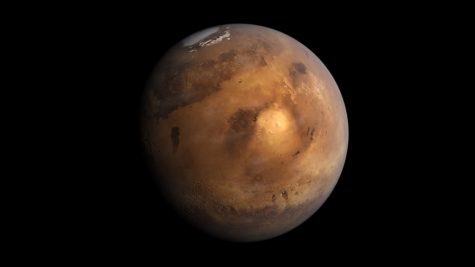NASA’s Perseverance Rover Lands Safely on the Red Planet
Photo by NASA JPL
March 2, 2021
The screen fades from black as the heat shield that protects the payload from the friction of the atmosphere is separated from the rocket and drops away. For a moment, the reflection from the inner belly of the heat shield blinds the camera before the brownish-orange expanse of Mars is revealed.
As the camera shifts, more of the landscape becomes visible: protruding ridges, darkened craters, and snake-like divots on the surface. NASA’s Mars Perseverance Rover falls quickly towards the planet’s surface with only a parachute to slow it. One hundred and twenty-seven seconds after the rover got an initial glimpse of its new home, it begins the landing maneuver.
The entire craft is slowed to about two miles per hour by four pairs of thrusters. The Perseverance Rover itself is then lowered from the thrusters by three cables and it touches down on the red planet. Finally, the thruster mechanism, known as the sky crane, launches itself as far as possible from the rover with the fuel that it has left.
This entire sequence, including entry into Mars’ atmosphere, descent to the surface, and landing maneuver has been lovingly dubbed “the seven minutes of terror.“ Seven minutes is the amount of time it takes for the spacecraft to get from the top of Mars’ atmosphere to rover touch-down, slowing from about 12,000 miles per hour to zero. And because of the 132 million mile separation between Earth and Mars, the Perseverance had to complete “the seven minutes of terror“ completely on its own.
No remote controls, just trust in the work that had been done. If anything went wrong and Perseverance had failed to land, it would still take approximately eleven and a half minutes for a radio signal to alert the NASA team back on Earth.
NASA’s Jet Propulsion Laboratory in Pasadena, California was only filled with cheers and applause because on Thursday, February 18, 2021 at 3:55 EST, Perseverance was confirmed to have completed its almost seven-month journey with a safe landing.
 According to NASA, Perseverance’s main mission is to search for signs of past life that may have existed on Mars. Scientists know that billions of years ago, Mars was home to many bodies of water that could have hosted some form of life. Although the water is long gone from the surface of Mars, Perseverance landed at the site of an ancient Martian lake called Jezero Crater where it will collect rock samples that can be analyzed onboard. NASA also plans to bring the samples to Earth for further study.
According to NASA, Perseverance’s main mission is to search for signs of past life that may have existed on Mars. Scientists know that billions of years ago, Mars was home to many bodies of water that could have hosted some form of life. Although the water is long gone from the surface of Mars, Perseverance landed at the site of an ancient Martian lake called Jezero Crater where it will collect rock samples that can be analyzed onboard. NASA also plans to bring the samples to Earth for further study.
The deputy project scientist for the Perseverance mission, Ken Williford, said that “shoreline sediments that could be encrusted with carbonate minerals“ is the best place to look for signs of life because carbonate minerals are “especially good at preserving certain kinds of fossilized life on Earth.“
The Perseverance Rover also has a multitude of other instruments such as the laser firing SuperCam, X-ray tool called PIXL, and chemical analyzer SHERLOC that will be used in the search for ancient life.
The mission also includes the launching of the small Ingenuity helicopter which will be the first powered flight on Mars. Ingenuity is mostly a test flight to demonstrate the technology, but it may also manage to snag some photos while it is in the air.
NASA says that Perseverance’s mission is set to last for at least one Martian year, about 687 earth days, and is part of the much larger goal of human exploration on Mars.





















Zayne Gladsden • Apr 30, 2021 at 2:53 PM
Hi Ren,
I found this article very interesting, specifically regarding the procedure in which the rover is constructed to follow when touching down on Mars. I also appreciate the introductory paragraph as it captivated me straight away with its action-packed sequence. I also really enjoyed the facts you included throughout the article as it helped me understand the gravity (no pun intended) of the procedure. I couldn’t believe that Perseverance can go from 12,000 miles per hour to just 0 in a matter of seven minutes. Overall, I really enjoyed reading this article and hope to read more in the future!!
Cheers,
Zayne